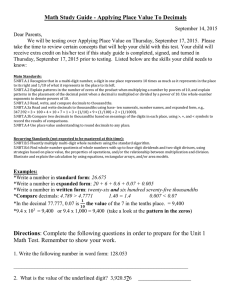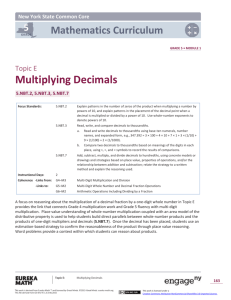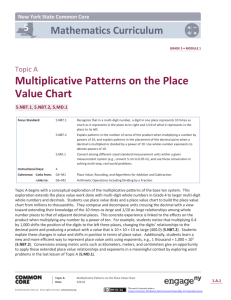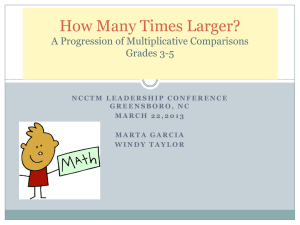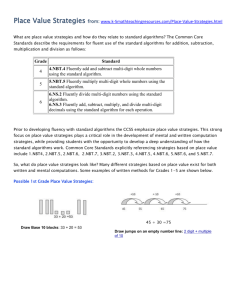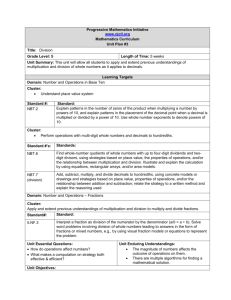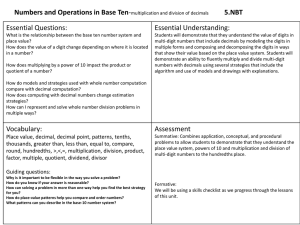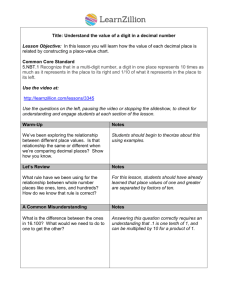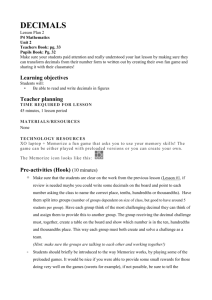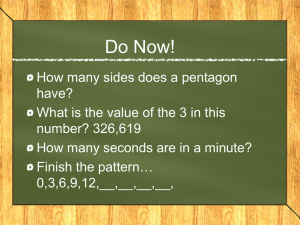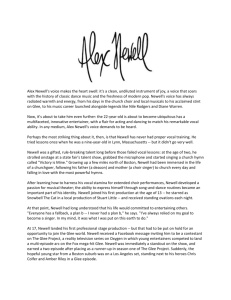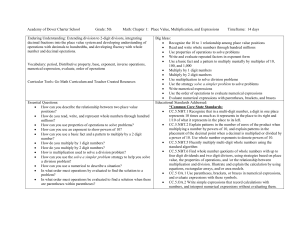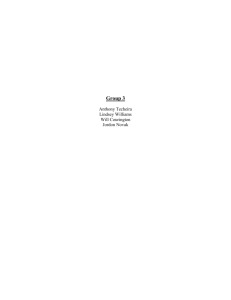Unit plan Numbers and Oper. Base Ten
advertisement
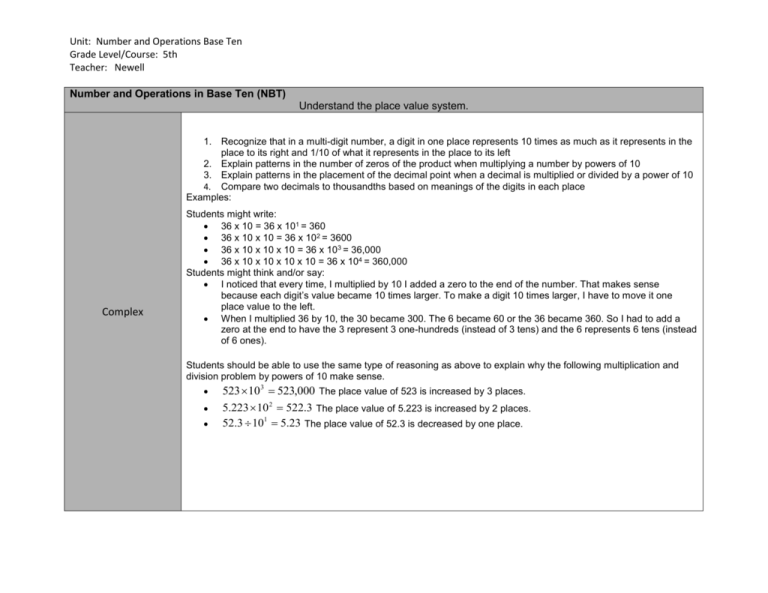
Unit: Number and Operations Base Ten Grade Level/Course: 5th Teacher: Newell Number and Operations in Base Ten (NBT) Understand the place value system. 1. Recognize that in a multi-digit number, a digit in one place represents 10 times as much as it represents in the place to its right and 1/10 of what it represents in the place to its left 2. Explain patterns in the number of zeros of the product when multiplying a number by powers of 10 3. Explain patterns in the placement of the decimal point when a decimal is multiplied or divided by a power of 10 4. Compare two decimals to thousandths based on meanings of the digits in each place Examples: Complex Students might write: 36 x 10 = 36 x 101 = 360 36 x 10 x 10 = 36 x 102 = 3600 36 x 10 x 10 x 10 = 36 x 103 = 36,000 36 x 10 x 10 x 10 x 10 = 36 x 104 = 360,000 Students might think and/or say: I noticed that every time, I multiplied by 10 I added a zero to the end of the number. That makes sense because each digit’s value became 10 times larger. To make a digit 10 times larger, I have to move it one place value to the left. When I multiplied 36 by 10, the 30 became 300. The 6 became 60 or the 36 became 360. So I had to add a zero at the end to have the 3 represent 3 one-hundreds (instead of 3 tens) and the 6 represents 6 tens (instead of 6 ones). Students should be able to use the same type of reasoning as above to explain why the following multiplication and division problem by powers of 10 make sense. 523 10 3 523,000 The place value of 523 is increased by 3 places. 5.223 102 522.3 The place value of 5.223 is increased by 2 places. 52.3 101 5.23 The place value of 52.3 is decreased by one place. Unit: Number and Operations Base Ten Grade Level/Course: 5th Teacher: Newell 1. Identify the digit’s place value on the right side of the decimal point and the left side of the decimal point 2. Use whole number exponents to denote powers of 10 3. Understand the rule for multiplying and dividing by a power of 10 4. Read, write, and compare decimals to thousandths. 5. Read and write decimals to thousandths using base-ten numerals, number names, and expanded form 6. Use >, =, and < symbols to record the results of comparisons 7. Use place value understanding, to round decimals to any place Example: Round 14.235 to the nearest tenth. Students recognize that the possible answer must be in tenths thus, it is either 14.2 or 14.3. They then identify that 14.235 is closer to 14.2 (14.20) than to 14.3 (14.30). In the number 55.55, each digit is 5, but the value of the digits is different because of the placement. Simple 5 5 . 5 5 The 5 that the arrow points to is 1/10 of the 5 to the left and 10 times the 5 to the right. The 5 in the ones place is 1/10 of 50 and 10 times five tenths. 5 5 . 5 5 The 5 that the arrow points to is 1/10 of the 5 to the left and 10 times the 5 to the right. The 5 in the tenths place is 10 times five hundredths. Unit: Number and Operations Base Ten Grade Level/Course: 5th Teacher: Newell Planning for Question 2 Preview K-W-L Share teacher prepared notes Critical Input Chunk Teacher will: Model how to identify the place value of whole numbers as well as fractions(decimals) by a power of 10 Show videos and/ or demonstration of exponents Give a demonstration on how to use <,>,= Show videos on place value Model how to use place value to round decimal to any place http://www.teachertube.com /viewVideo.php?video_id=162 235 &title=Exponents_by_Natalie Actively Process Student(Groups) will: Use base ten blocks, pictures of base ten blocks, and interactive images of base ten blocks to manipulate and investigate the place value relationships. Read, write, and compare decimals to thousandths Read and write decimals to thousandths using base-ten numerals, number names, and expanded form Resources: Please add any text page numbers, web links, articles, or other unit resources here. EMD: 5.NBT.1 Lesson 2.2,7.2 5.NBT.2 2.1,2.7,2.8,2.9,3.2,3.5,3.8,3.9,4.1,7.2,7.3,9.5,11.6 5.NBT.3 Planning for Question 3 Students will: They use their understanding of unit fractions to compare decimal places and fractional language to describe those comparisons Independent practice – Students will do 5-12 problems daily. Planning for Question 4 Unit: Number and Operations Base Ten Grade Level/Course: 5th Teacher: Newell 5.NBT.3a 2.2,2.3,2.4,2.5,2.8,3.9,5.5,5.6,5.7,5.8,5.9,6.2,6.3,6.7,9.4 5.NBT.3b 2.5,7.9 5.NBT.4 2.5,7.9 2.5,2.7,2.8,3.6,5.5,5.6,5.8,6.1,6.4,9.8,10.7,10.8,11.3,12.7 Unit: Number and Operations Base Ten Grade Level/Course: 5th Teacher: Newell Number and Operations in Base Ten (NBT) Perform operations with multi-digit whole numbers and with decimals to hundredths. Complex 1. Fluently multiply multi-digit whole numbers using the standard algorithm 2. Find whole-number quotients of whole numbers with up to four-digit dividends and two-digit divisors 3. Use strategies based on place value, the properties of operations, and/or the relationship between multiplication and division 4. Illustrate and explain the calculation by using equations, rectangular arrays, and/or area models 5. Relate the strategy to a written method and explain the reasoning used. 1. Know multiplication facts 2. Know Division facts 3. Know how to Add, Subtract, Multiply, and Divide using standard algorithms 4. Identify and Use the correct algorithm in multiplying a multi-digit problem Simple Preview KWL Chart Overt linkages Brief teacher Summary Planning for Question 2 Critical Input Chunk Planning for Question 3 Actively Process Planning for Question 4 Unit: Number and Operations Base Ten Grade Level/Course: 5th Teacher: Newell Teacher prepared notes Museum or picture walk Ask or give preview questions Skimming Speed reading Review past learning Quick write/draw Give clues, cues Anticipation guide Focused free write Interactive cloze Focused listing PreP Post learning concept checks Pre Test Unit: Number and Operations Base Ten Grade Level/Course: 5th Teacher: Newell Resources: Please add any text page numbers, web links, articles, or other unit resources here.
